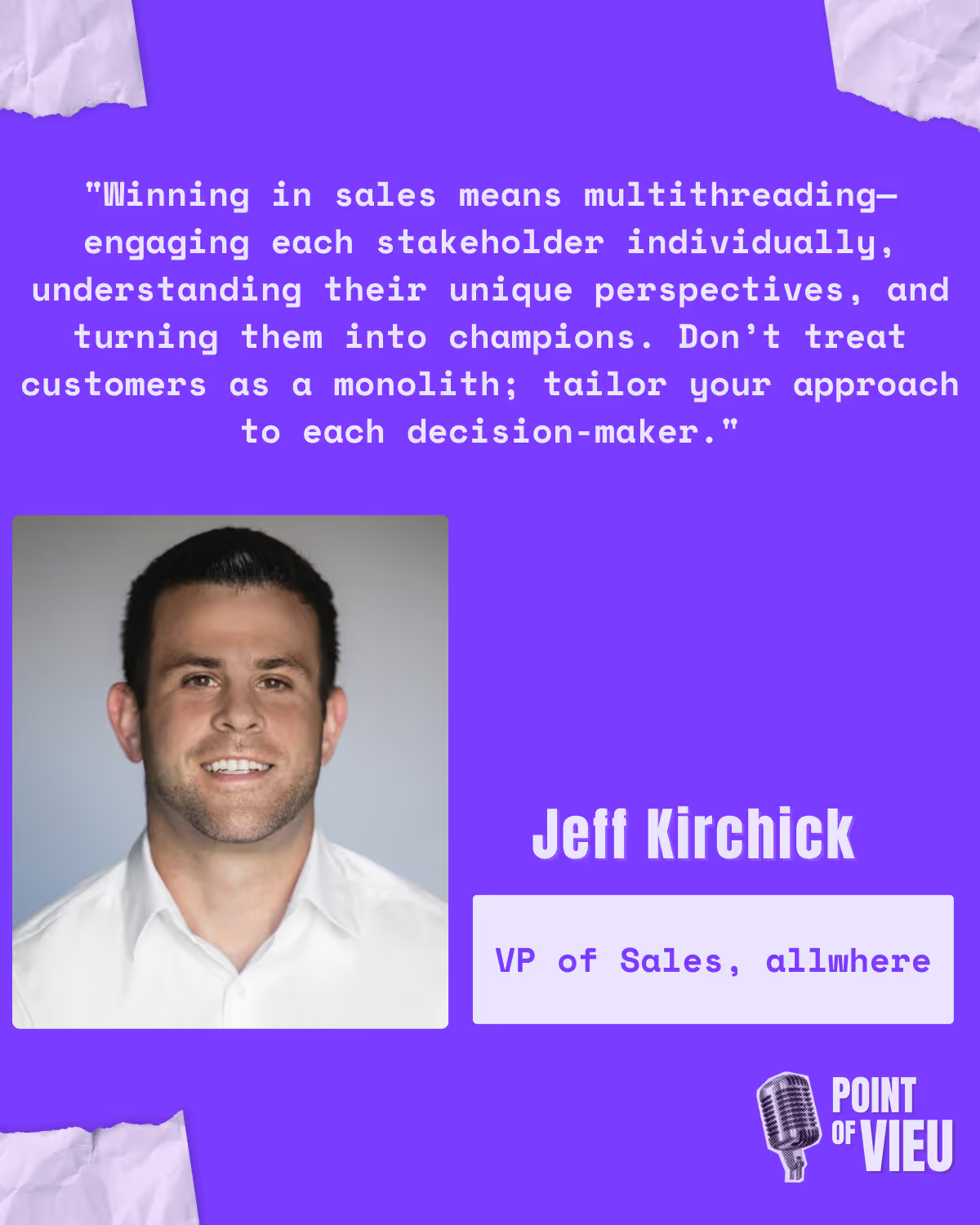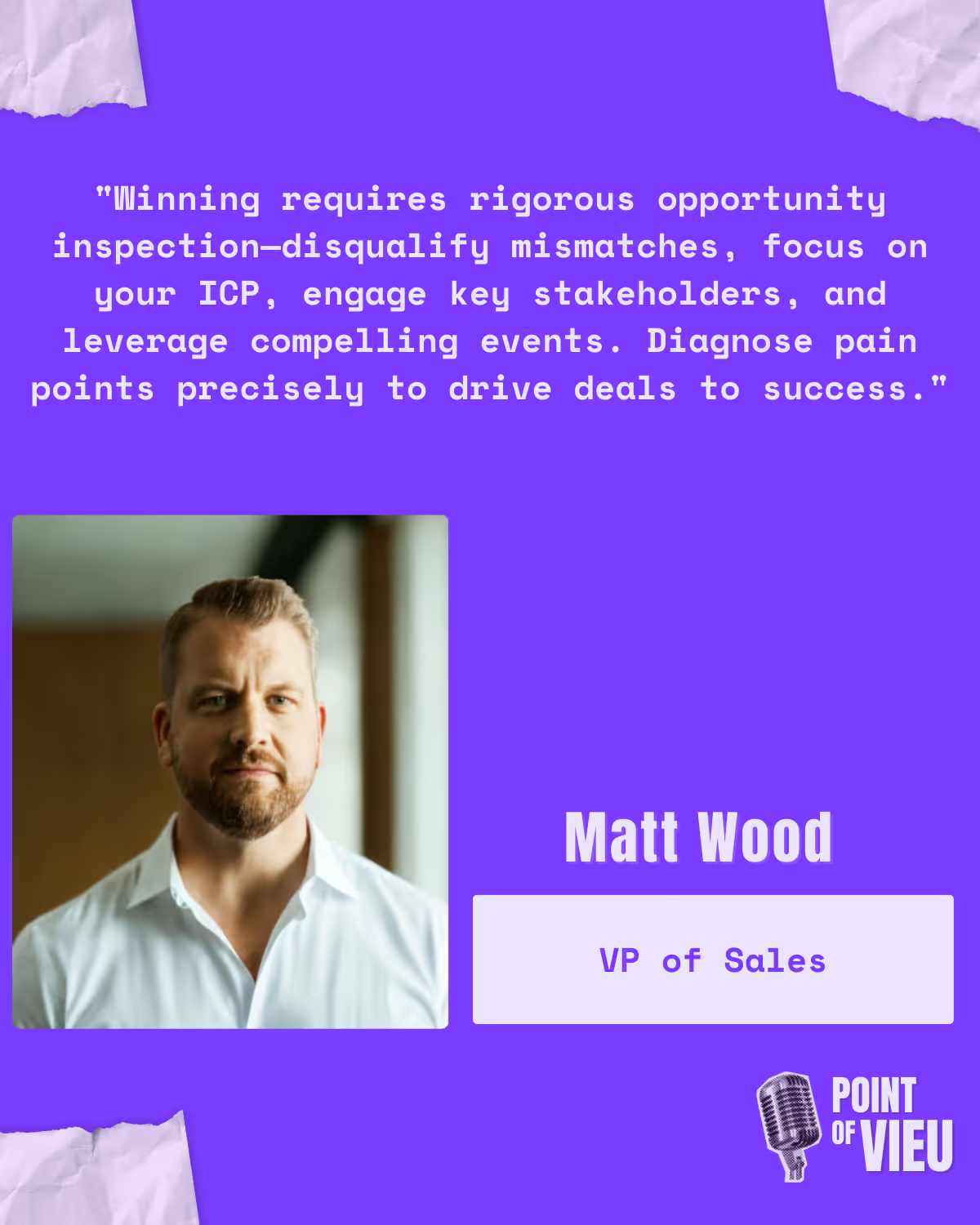In the fast-paced world of B2B sales, where the stakes are high and the competition fierce, the insights of seasoned sales experts can be invaluable. These leaders have honed their skills across various industries, driving significant revenue growth and steering their teams through challenging economic climates.
From the importance of multithreading to the intricacies of building a robust top-of-funnel, their experiences shed light on what it takes to excel in today's market. Whether it's understanding customer pain points, amplifying the value of solutions, or leveraging data effectively, their strategies and philosophies offer practical guidance for sales professionals looking to navigate the complexities of the enterprise landscape.
In the previous four episodes, we discussed the following:
In this episode, we discuss how to win pipeline in today’s market.
Watch our experts answer the question: “How are you winning pipeline in today’s market?”
Read on to know the tips given by our experts:
Nikita Zhitkevich, VP of Sales, PartnerStack

Nikita is the VP of Sales at PartnerStack, an organization dedicated to helping companies launch and scale their channel and partner programs across the board.
“I read something recently which said that businesses that get it right are the ones that care to get all the little things right. I think that's even true in our kind of current economic standing. Customers care about attention to detail. They check whether you show genuine care to solving their problems.
I always ask myself the questions like: “How do you bring that pipeline over from the customer's perspective? How do we help our customers solve their problems faster? How do we help our customers drive more success, and how do we help our customers you become champions and ultimately get promoted?”
For instance, implementing Partnerstack can help an organization put infrastructure around the partner channel to help scale it. Get that champion promoted from a manager to a director, director to a VP, even to a CRO at some point. That's our goal and mission.
In the current SaaS downturn, it's about getting the little things right. It's about ensuring that you truly understand your customer's pain point, what helps them drive the needle, and can your solution help them do that?
I think there are many solutions out there that are good, but they don't amplify their value.
They don’t answer questions like: “How do you help me drive more of x, or how do you help to decrease churn substantially?”
You should dig in and try to understand that pain point and understand how to implement every piece of software. It might only cost $15,000.
But it's not just the $15,000. It's all the time, the implementation resources, and the internal political navigation to get those resources assigned to your project. Every single implementation is its own challenge in a lot of different ways.
It's all about being incredibly customer centric and aligning with your existing customer's needs. Follow up when you say want to follow up. Give them the resources in advance. Put them in touch with additional customers so that they feel comfortable. Other people in the organization might not be as comfortable bringing in a new tool. So how do you bring all those things together to round out the conversation?”
Jeff Kirchick, VP of Sales, allwhere

Jeff Kirchick is the Vice President of Sales at allwhere, an IT asset lifecycle management software company based in New York City with approximately 45 employees. With 15 years of experience in software sales, Jeff has been a part of multiple successful exits.
“I think people can do many things. It kind of depends on what type of segment you sell into. Right now, I actually don't sell much enterprise solutions. But in my career, enterprise selling to some of the top banks has played a huge part. One of the big themes that you'll be seeing a lot of is multithreading.
You've got an economic buyer and a champion, but pion, but I think that you have different types of champions, and you have different types of buyers. You have buying committees, and people that influence deals in different ways. Therefore, if you really want to stand out from other vendors, you should do good multithreading.
In my last company, four different stakeholders needed to be aligned to be with if I wanted to get a deal done. Did I absolutely need all four all the time? Not necessarily. But if I had all four, it would be hard for me not to win a deal.
So, what that meant was that I might have had a day-to-day champion. But I also needed to understand the IT team’s requirements. I needed to understand the requirements of the digital team and what they were trying to build for.
You might have a demo with a client, and some people are passive and quiet or they're asking some hard-hitting questions about their concerns.
Other people are getting excited about different things. There's a good thing I like to do after demos, like picking people off individually. I don't just send one email to everybody.
Everyone had a different experience. If you found someone on that demo who got excited about a use case, email them afterwards and say, ‘hey, I saw you got excited about this use case when we were on the call. I'd love to spend more time with you individually so we can peel the onion on that.’
Maybe you have the IT person who is being one the call and asking you all these questions about integration. I will reach out to him and clarify his doubts.
My whole point is that you don't treat the customer like a monolithic group. They're all coming from different perspectives on how they're going to arrive to a decision.
So, I think the best thing good sellers can do is not be lazy. Do the extra leg work to reach out to the different individual personas, understand their pain points, and help them become champions. When everyone's a champion for your solution, you will win.”
Matt Wood, VP of Sales

Matt Wood has spent approximately a decade in SaaS, playing a pivotal role in scaling revenue growth across multiple organizations within DevOps, cybersecurity, and data observability. His efforts have driven revenue from below $1 million to over $100 million, contributing to four successful mergers or acquisitions.
“You must win every opportunity, but you should also disqualify opportunities that should not be in there. Go through rigorous opportunity inspection, to understand your ICPs and their pain points.
Identify a compelling event you can use to win the deal – that will be important as well. So, hone in on the ICP, ensure you're talking to the key stakeholders, understanding what's important to them, and then finding compelling events.
Ensure that you're really identifying and diagnosing that pain so you can drive that deal to a win.”
Ayush Sharma, Director of Sales, Rippling

Ayush currently leads the sales team at Rippling, Bangalore. His teams serve the US, EMEA, and Indian markets. He has seven years of experience in the B2B Saas space. He worked for companies like Whatfix for four years and worked at another Silicon Valley company called Carta.
“In any market, any given time of sales, the top of the funnel is super important. At the end of the day, what you get in your pipeline, you massage the pipeline, and then you get an output out of it.
We've already spoken about strategies and how you can massage your pipeline and get more extracted from what you have in the pipeline. But also at the same time, how can you increase the top of funnel? How are you getting more deals in your pipe?
That's super important. So, every sales leader, director of sales, VP of sales must have a strong relationship with marketing. Marketing is the biggest driver of your top of the funnel.
You can do thousands of things with inbounds, your, SEOs, LinkedIn paid ads, and more. You can do webinars. You can participate in events to boost your pipeline. So, you can do campaigns of various sorts, and then the second aspect is how do you ensure that you're running that pipeline tightly? You should get your basics right. Basics like Salesforce hygiene, basics like how you are running your one on ones with your reps. A lot of times we have seen managers run one-on-one, and the rep is leading that one-on-one.
It's never that way. The one on one is your manager's meeting. That's my 30 minutes. I will run the way I want. I will ask the questions to the rep. So, that expectation must be clear with the rep so that you are maximizing the approach, making sure the pipeline depicts the right picture, and we don't have stale ops in the pipeline.
Obviously, training is crucial because that will eventually lead your reps to be confident and do the best projection of your product in front of your buyers. One more suggestion from my side is to use data smartly. I've seen many times that big companies use data to prove their hypothesis rather than running hypothesis with the data.
For instance, I have a few hypotheses, and I will see if the data proves one right and the other wrong, or the other way. But that's not how I've seen some companies use data. They use data to validate their biases and hypothesis.”
Conclusion
We meticulously manage our pipeline, effectively multithread, and leverage data to make informed decisions. These actions share a common thread: our dedication to aligning with customer needs and fostering strong, collaborative relationships. The path to success in sales remains complex, but the right mindset and tools lead to both individual and organizational triumph.



